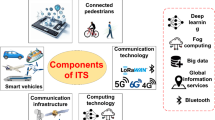Abstract
Recent decades have witnessed the fast development of high-speed railway systems in many countries, which have significantly shortened the travel time between distant cities. Accompanied with this convenience is the challenge for cell phone vendors to provide broadband Internet access for passengers, particularly considering the fast changing channel conditions in high-speed trains and the limited battery of cell phones, which often cannot be re-charged in trains. In this paper, inspired by the unique spatial-temporal characteristics of wireless signals along high-speed railways, we propose a novel energy-efficient scheduling approach for uploading data from cell phones, both with soft deadlines (e.g., documents) and hard deadlines (e.g., video streaming). Our solution effectively predicts the signal strength through its spatial-temporal periodicity in this new application scenario, and smartly adjusts the transmission rate to maximize the overall data transmission rate and yet conserves the energy consumption. Performance evaluation based on realistic railway scenarios and H.264 video traces demonstrate the effectiveness of our solution and its superiority as compared to the existing solutions.









Similar content being viewed by others
References
Holma H, Toskala A (2007) WCDMA for UMTS: HSPA evolution and LTE. Wiley, New York
Uhlirz M (1994) Concept of a GSM-based communication system for high-speed trains. In: Proceeding of IEEE VTC 1994, pp 1130–1134
Abrishamkar F, Irvine J (2000) Comparison of current solutions for the provision of voice services to passengers on high speed trains. In: Proceeding of IEEE VTC 2000, pp 2068–2075
Fokum DT, Frost VS (2010), A survey on methods for broadband internet access on trains. IEEE Communications Surveys and Tutorials 12(2):171–185
Jang K, Han M, Cho S, Ryu H-K, Lee J, Lee Y, Moon S (2009) 3G and 3.5G wireless network performance measured from moving cars and high-speed trains. In: ACM Workshop on Mobile Internet through Cellular Networks: Operations, Challenges, and Solutions (MICNET) 2009, pp 295–298
Cheng X, Li Y, Cao X (2009) The discussion on gsm coverage scheme of high-speed railway. In: Proceedings of IEEE International Conference on Communications Technology and Applications (ICCTA) 2009, pp 295–298
Schulman A, Navda V, Ramjee R, Spring N, Deshpande P, Grunewald C, Jain K, Padmanabhan V (2010) Bartendr: a practical approach to energy-aware cellular data scheduling. In: Proceedings of MobiCom 2010, pp 85–96
De Greve F et al (2005) Famous: a network architecture for delivering multimedia services to fast moving users. Wirel Pers Commun (Springer) 33(3–4):281–304
Rao K R, Zoran S, Dragorad A (2009) Wireless multimedia communications: convergence, DSP, QOS, and security. CRC Press, Boca Raton
van Der Schaar M, Sai Shankar N (2005) Cross-layer wireless multimedia transmission: challenges, principles, and new paradigms. IEEE Wirel Commun 12(4):50–58
Salton E, Yoo T, Zhu X, Goldsmith A, Girod B (2005) Cross-layer design of ad-hoc networks for real-time video streaming. IEEE Wirel Commun 12(4):59–65
Long X, Sikdar B (2008), A real-time algorithm for long range signal strength prediction in wireless networks. In: Proceedings of IEEE WCNC 2008, pp 1120–1125
Kobayashi K, Matsunaga Y (2009), Radio quality prediction based on user mobility and radio propagation analysis, In: Proceedings of IEEE PIMRC 2009, pp 2137–2141
Yates RD (1995) A framework for uplink power control in cellular radio systems. IEEE J Sel Areas Commun 13(7):1341–1347
Sung CW, Wong WS (2002) Power control and rate management for wireless multimedia cdma systems. IEEE Trans Commun 49(7):1215–1225
Catrein D, Imhof LA, Mathar R (2004) Power control, capacity, and duality of uplink and downlink in cellular CDMA systems. IEEE Trans Commun 52(10):1777–1785
Rappaport TS (1996) Wireless communications. Prentice Hall, Englewood Cliffs
He R, Zhong Z, Ai B (2010) Path loss measurements and analysis for high-speed railway viaduct scene. In: Proceedings of International Wireless Communications and Mobile Computing Conference (IWCMC) 2010, pp 266–270
Stojmenovic I, Lin X (2001) Power-aware localized routing in wireless networks. IEEE Trans Parallel Distrib Syst 12(11):1122–1133
Seeling P, Fitzek FHP, Reisslein M (2007) Video traces for network performance evaluation: a comprehensive overview and guide on video traces and their utilization in networking research. Springer, Berlin
Seeling P, Reisslein M, Kulapala B (2004) Network performance evaluation with frame size and quality traces of single-layer and two-layer video: a tutorial. IEEE Communications Surveys and Tutorials 6(3):58–78
Van der Auwera G, David PT, Reisslein M (2008) Traffic and quality characterization of single-layer video streams encoded with H.264MPEG-4 advanced video coding standard and scalable video coding extension. IEEE Trans Broadcast 54(3):698–718
Constandache I, Choudhury RR, Rhee I (2010) Towards mobile phone localization without war-driving. In: Proceedings of IEEE INFOCOM 2010, pp. 1–9
Acknowledgements
This research is supported by a Canada NSERC Discovery Grant, an NSERC DAS grant, an NSERC Strategic Project Grant, and an MITACS NCE Project Grant.
Author information
Authors and Affiliations
Corresponding author
Rights and permissions
About this article
Cite this article
Ma, X., Liu, J. & Jiang, H. Energy-Efficient Mobile Data Uploading from High-Speed Trains. Mobile Netw Appl 17, 143–151 (2012). https://doi.org/10.1007/s11036-011-0297-3
Published:
Issue Date:
DOI: https://doi.org/10.1007/s11036-011-0297-3




